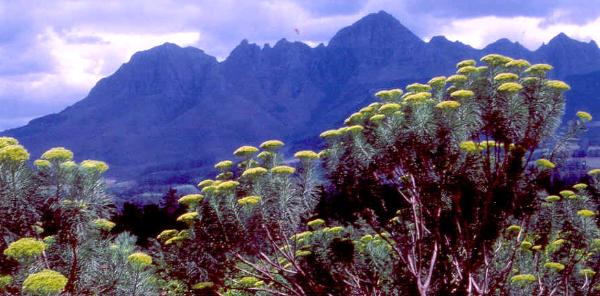 |
Flora of the Western Cape
|
The Western Cape Province
of South Africa is part of what used to be called the Cape Province which
made up almost half of the country. That area was subsequently divided
into the Western Cape, the Eastern Cape and the Northern Cape, each with its own provincial premier and legislature. The
Western Cape is centered around the city of Cape Town and is more or less
crescent-shaped, with the flank of its northern horn facing west toward
the Atlantic and the flank of its eastern horn facing south toward the
Indian Ocean. The population of the Western Cape is approximately 5.3 million with Afrikaans being the rincipal language spoke. The Western Cape Province shares with Southern California
the distinction of being among the five regions of the world which harbor
what is referred to as Mediterranean vegetation, the others being southwestern
Australia, western Chile, and of course, the coastal Mediterranean. It
is obviously no coincidence that these regions have developed similar
types of vegetation, because even a cursory glance at a world map reveals
that all of them are situated approximately the same distance from the
equator, with Chile, South Africa and Australia being between 30°
and 40° south of that line, and Southern California and the Mediterranean
being between 30° and 40° north of it, and all of them are either
on the western edges of continents or are influenced by prevailing winds
from the west. |
|
The Cape Floral Kingdom
or Floristic Region is the smallest of the six such natural areas in the
world, and is the only one contained within the borders of a single country.
The others are the Boreal or Paleoarctic, Australasian, Neotropic,
Paleotropic, and Antarctic. The Antarctic kingdom, although itself
quite small, is nevertheless some 25 times as large. The CFK comprises
less than 0.04% of the earth's land surface, yet harbors 3% or 4% of the
world's species. All of tropical Africa contains some 30,000 plant
species in almost 20 million square kilometres, which is only 3.5 times
as many species in an area 235 times as large. The British Isles,
at 3.5 times as large as the CFK, has only 1,500 species compared to the
Cape's 8,600. And it is not merely its botanical diversity and richness
that is significant. Almost 70% of its species are found nowhere
else on earth. Unfortunately, almost three-quarters of all the species
in South Africa's IUCN Red Data book of threatened or endangered species
are currently growing in this Floral Kingdom, and this means that hundreds
of species are facing extinction. |
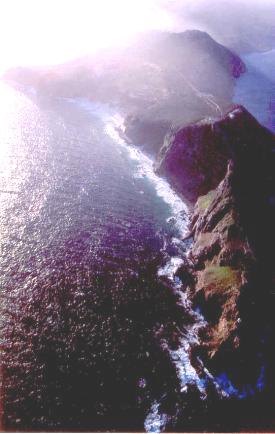 |
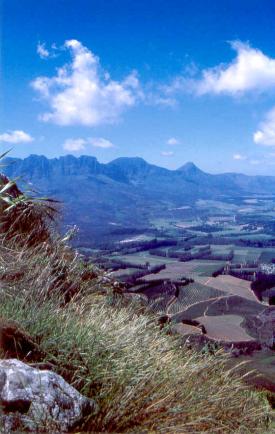 |
|
Let us be clear here
on what areas we are talking about. The terms Western Cape Province,
Cape Floral Kingdom (or Floristic Region or Province), and fynbos biome
are often confusing, and were to me before I started writing this. They
don't refer to exactly the same thing. The Western Cape Province
is a specific bordered area that stretches about 375km north and about
480km east of Cape Town. The fynbos biome comprises the majority
of the Cape Floristic Region, but does not include those areas of so-called
succulent karoo vegetation in the far northern region of the Western Cape
Province, those areas of nama karoo vegetation in the northeastern part
of the Province, and some small patches of sub-tropical thicket and afromontane
forest primarily in the Eastern Cape Province, all of which are properly
considered part of the Cape Floral Kingdom (see map).
It should also be pointed out that both the Cape Floral Kingdom
and the fynbos biome extend well beyond the boundaries of the Western
Cape all the way to Port Elizabeth in the Eastern Cape. The Cape
Floral Kingdom thus occupies virtually the entire Western Cape Province,
a small area in the western part of the Eastern Cape Province, and some
very tiny sections of the Northern Cape Province adjacent to the Western
Cape. Percentagewise, about 70% of the CFK and fynbos vegetative
area is in the Western Cape, about 25% in the Eastern Cape, and about
only about 5 % in the Northern Cape. |
The
primary vegetation type of the Western Cape is fynbos, a term derived
from Dutch and Afrikaans words meaning "fine bush," which typically
grows on fairly nutrient-depleted mostly sandstone-derived acidic soils
and is dominated by sclerophyllous, that is, evergreen, hard-leaved, flowering
shrubs, many of which are proteas, ericas, cape reeds (Restios) , and
geophytes (bulbed plants). Fynbos is technically described as a
vegetation that has more than a 5% cover of Restios and exists in a fire-controlled
ecosystem characterized by significant winter rainfall, nutrient-poor
soils, and exceptional floristic richness and endemism. While two
basic types of fynbos, mountain fynbos and lowland fynbos, have been described,
references are often made to coastal fynbos on sandy alkaline soils and
limestone fynbos. In fact, one authority has categorized fynbos
into five separate vegetative types, and there is no doubt that fynbos
communities in different areas are not exactly the same depending on season,
soil, slope, altitude and rainfall. However, although they may not
contain precisely the same species, they are structurally very similar.
Lowland fynbos has perhaps more annuals and grass species, and is
limited for the most part to sandy, clay or limestone soils. In
addition to sandstone-derived soils, mountain fynbos may grow where rainfall
is sufficiently high on leached soils derived from granites or even shales.
Trees are relatively rare in mountain fynbos but some that do grow
there are the Clanwilliam cedar, the silver tree, the wild olive and the
mountain cypress. It is certainly to be suspected that the distinction
between these two vegetative types is to some extent an artificial one,
and obviously one can keep dividing areas into smaller and smaller sub-units
almost indefinitely. Fynbos makes up about 80% of all the vegetation of
the Cape Floral Kingdom, and it clearly bears a striking similarity
to Southern California's chaparral, but due to the relatively poor quality
of the soil, the shrubs are generally smaller and spaced farther apart,
making it easier to move through than is the case with chaparral. Like
our chaparral, this vegetative type is well adapted to fires, and even
requires a cycle of fires of from six to forty-five years to prevent the
plants from aging and degenerating, and allowing the invasion of thicket
and forest. It is not necessary here nor will I attempt to delineate
any differences between the various fynbos types or plant communities,
but let it suffice to say that of the approximately 8,600 species in the
Cape region, some 7,000 of them are present in the fynbos biome.
Thus the relationship between the fynbos biome and the Cape Floral Kingdom
is sufficiently great that they can be forgiven who associate the two
as one. |
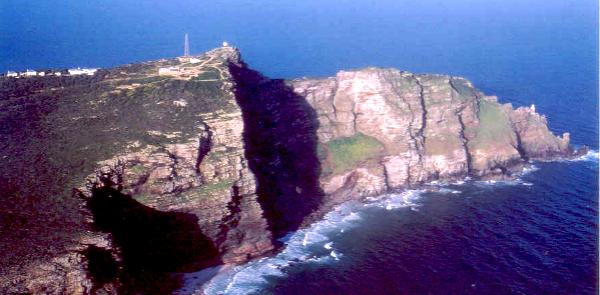 |
|
A second vegetation
type within the fynbos biome that superficially resembles fynbos is called
renosterveld and is found in both in the coastal lowlands and the mountains,
and dominated to some extent by the renosterbush, Elytropappus rhinocerotis,
in the Asteraceae family. Renoster means rhinoceros in Afrikaans,
and is probably a reference to the historic habitat of the black rhino.
In the past, because of its richer soils, which are generally more
fine-grained clays or silts, renosterveld supported quite extensive populations
of many of the large species of animals such as cape buffalo, elephant,
rhino, eland, zebra, lion and cheetah, but those animals are mostly gone
now except where they have been reintroduced. Also because of its
more fertile soils, much of the renosterveld area has been agriculturalized.
There is a great species richness of geophytes, especially irises,
lilies and orchids. Generally speaking, renosterveld lacks the Restios
(although grasses are abundant), and proteoids are either absent or quite
uncommon. Fairly low ericoid shrubs with small, tough leaves predominate,
with a lower layer of the grasses and seasonally-active geophytes. The
Asteraceae is one dominant family. Rainfall in areas harboring this
veld type is usually from 25 to 60cm a year. Where rainfall is higher,
renosterveld is replaced by fynbos, and where lower by succulent karoo.
Like fynbos, renosterveld is fire prone, and has been referred to as the
most endangered vegetation type in the Cape Floral Kingdom. |
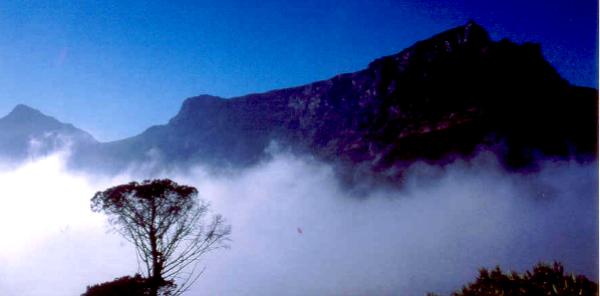 |
The
species density and diversity throughout the Western Cape is highly extraordinary.
Although geographically the Cape Floral Kingdom occupies less than
5% of the area of South Africa, more than 40% of all South African plants
are to be found there. There is one report of 121 species being
recorded for an area of 100 square meters! The largest family is
the Asteraceae with over 1000 species, the largest genus of which is Senecio.
There are roughly 765 species of Ericas, 624 species of Irises,
728 species of Mesembryanthemums, 606 species of legumes, 322 species
of Proteas, 315 species of Cape Reeds, and 220 species of orchids (see
table). These figures are higher than
in the table, because it is from 1984. Table Mountain itself is
home to almost 1,500 species, more than the entire United Kingdom. The
reason for this incredible diversity appears to lie primarily in the topographic
and climatic variety which characterizes the Western Cape Province. The
convergence of the Atlantic Ocean and Indian Ocean weather systems, as
well as a multiplicity of topographic features such as coastal plains,
narrow valleys, high plateaus and steep escarpments, has conspired to
create an enormous array of habitats and microclimates within which these
many thousands of species have evolved. Other factors leading to a high floristic diversity are a complex rainfall pattern with precipitation amounts ranging from 20cm to 200cm, varied soil types, the frequency of fires producing in some reseeding species shorter generational times and thus higher speciation rates, the evolution in many species of short seed dispersal distances, a significantly higher pollinator diversity, and, perhaps as important as any of these, a relatively stable climatic history throughout the Pleistocene era which resulted in lower extinction rates and relatively more numerous local speciation events. Beyond this, many of the fynbos species have had to adapt to the harsh nutrient-deprived soils, and this accounts in large degree to the high level of endemism which is prevalent throughout the Cape. The region's peak blooming season is in the spring months of September and October, but there are numerous species in bloom throughout the year. It is interesting to note for Southern Californians that we share quite a few genera with South Africa, among which are Acacia, Apium, Asclepias, Clematis, Cotula, Crassula, Cuscuta, Euphorbia, Geranium, Hibiscus, Limonium, Linum, Lobelia, Lycium, Oxalis, Pellaea, Polygala, Polygonum, Psoralea, Ranunculus, Rhus, Salvia, Senecio, Silene, Solanum, Stachys, Typha and Viola. |
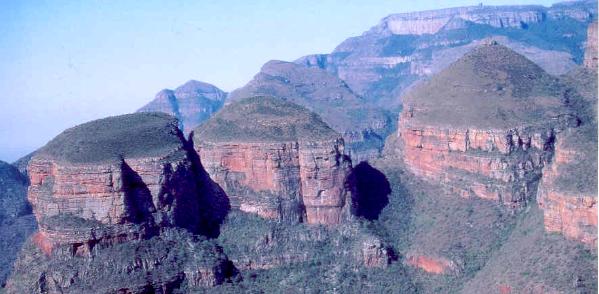 |
The
great majority of species of genus Erica in the world are endemic to South
Africa. Most of these are smallish shrubs with small, needle-like,
often down-rolled leaves with the stomata being positioned inside a very
narrow slit, upper surfaces which are hard and waxy, and delicate tubular
flowers The leaf characteristics are fairly common features of the
Ericas and are an adaptation to minimize water loss. Erica flowers
have eight anthers and four petals joined to form a tube or cup. Another
characteristic of the Ericas is that they have evolved a symbiotic relationship
with fungi which helps them to maximize nutrient absorption in the relatively
deprived soils of the Cape. About 80% of the Ericas are insect-pollinated,
and the pollinators are often flies. It is speculated that the Ericas
evolved after the breakup of Gondwanaland because they do not appear in
either South America or Australia. There are some 650 species
of Ericas in the Cape Province, giving them the highest degree of regional
speciation on earth. |
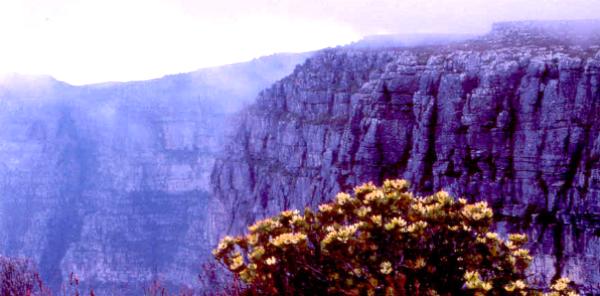 |
Proteas however are represented by fossil pollen found in Antarctica and
by living species in Central and South America. Their two most important
centers of distribution are South Africa and Australia, so they almost
certainly did evolve before Gondwanaland broke apart. They derive
their name from the Greek sea god Proteus, who had the power to take on
a great variety of shapes, alluding to the great diversity within this
family. Unlike the Ericas, Proteas are generally shrubs with broad
leaves and are mostly bird-pollinated. They are also characteristically
deep-rooted, and they all have somewhat woody stems. What appears to be
the protea flower is actually, like a sunflower, a flowering head made
up of many long, slender flowers surrounded by colorful bracts. Protea
flowers do not have separate petals and sepals. Instead, they have what
are sometimes referred to as tepals. The manner in which the tepals
separate after the bud opens and the extent to which they remain fused
at the base are characteristics which identify the various genera. The
anthers do not have long filaments, but are attached near the top of the
tepals, shedding their pollen onto the uppermost portion of the style
just before the flower opens. Some species have four small nectaries
situated at the base of the ovary which secrete nectar to attract pollinators.
Proteas develop small dry fruits each containing a single seed.
Some genera like Leucadendron have the sexes separated onto
separate plants. (See protea illustration)
|
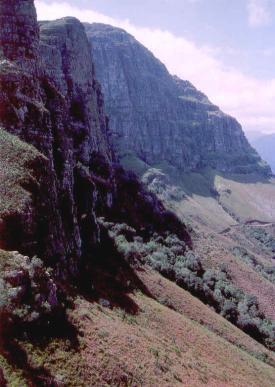 |
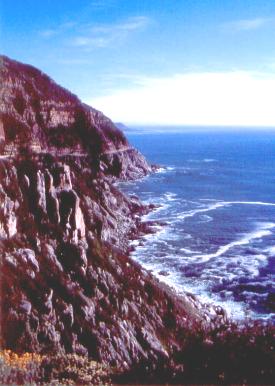 |
The
third major component of the Fynbos plant community is the Restionaceae,
also an old family that evolved in Gondwanaland. Of the approximately
480 species in the world, about 330 species inhabit the Cape region. These
rush-like plants thus occupy the position of the grasses that are so prevalent
elsewhere. The Restios are shallow-rooted with highly reduced dry,
brownish leaves, and grow in clumps with the taller species being about
waist high. Most of the species are dioecious. The flowering spikelets
at the ends of the stems typically give the landscape a greenish-brown
look. The stems or culms are green, mostly solid, and perform the work
of photosynthesis for the plant. The leaves are reduced to sheaths some
of which are persistent, and some of which drop off, and are positioned
at nodes along the stem. The male plants bears cones with pollen, while
the female plants have cones with feathery stigmas to collect the pollen.
Among the genera in this family represented in the Cape are Elegia,
Ceratocaryum, Restio, Cannomois, Rhodocoma, Calopsis,
Chondropetalum, and Thamnochortus. (See restio
illustration) |
|
Fynbos
is not the only plant community of the Cape Floral Kingdom. Another
community is called strandveld, or beach vegetation, and is composed primarily
of a shrubby flora found on sandy, well-drained and lime-rich soils. It
is to be found mainly along the Atlantic coast north of Cape Town. This
plant community is made up largely of succulents, bulbed geophytes, annuals
and so-called cape reeds or Restios, members of the Restionaceae family,
which have already been described. Strandveld contains a
lower species diversity and a smaller proportion of endemics, and may
more properly be considered as a transitional vegetation type between
fynbos and succulent karoo. There are also areas of woodland and
forest containing such trees as Leucadendron argenteum, the silver
tree, but these are not extensive. |
|
There are also other
biomes within the Cape Floristic Region, and botanists have referred to
these as subtropical thicket, succulent karoo and afromontane forest.
Let me reiterate that a biome is a major distinct ecological community
type or a biophysiological grouping of species of plants and/or animals
living together. It is the highest level of plant community, representing
a large and relatively uniform natural area, characterized by uniform
vegetative life forms closely related to and more or less governed by
climate. Succulent karoo is a biome which is not fire prone like fynbos
or renosterveld, and exists in areas of flat to gently undulating plains
with some hills and broken veld or grassland which supports a vegetation
of small, succulent-leaved shrubs including many species of Aizoaceae,
Mesembryanthemaceae, Crassulaceae and Asteraceae. There are numerous
annuals in spring and grasses are rare. The soils in this biome
are lime-rich and weakly developed. Rainfall varies from about 2cm-25cm
and summer temperatures are quite high. There is substantial species
richness, and a large number of rare and Red Data Book species present.
Little of the area has been conserved, but fortunately there are
few invasive alien plants. Lack of water results in low agricultural
potential. Subtropical thicket is a fairly dense, more-or-less closed
semi-succulent and spinescent evergreen shrubland to low forest, often
almost impenetrable, generally not stratified and with little herbaceous
cover. It is present in river valleys, on rock screes and coastal
dunes. Rainfall in this biome is too low to produce a genuine forest,
yet some degree of fire protection does exist. Most of the floristic components
of thicket are present in other biomes and there are few species endemics.
It is in some senses a transitional community. The afromontane
forest is a biome consisting of patches of closed-canopy, evergreen trees
which are afforded a large degree of fire protection by the high humidity
and rainfall that ranges from 70cm to 200cm. In the Western Cape
it occurs mostly on south-facing ridges and in ravines, but would likely
spread into at least some fynbos areas if it were not for the frequency
of fires there. Soils are generally well-developed and may be quite
deep in lower valleys. An understory often exists which is multi-layered
and can include many lianas and epiphytes, however ground cover is typically
lacking due to a high amount of shade. Two tree species which have
been harvested in the past are the black stinkwood, Ocotea bullata,
and the Outeniqua yellowwood, Podocarpus falcatus. |
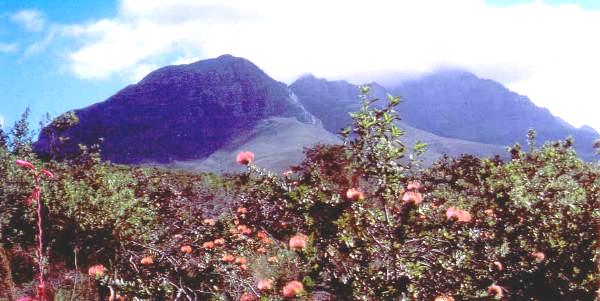 |
Up
until about 5 million years ago subtropical vegetation was prevalent in
the Cape area, but by that time the glaciation of the Antarctic continent
was complete, the cold Benguela current was influencing the Cape and a
Mediterranean climate pattern of moist winters and hot, dry summers had
become established, allowing fynbos vegetation to move into the area from
where it had existed previously further north. At present, the greatest
amount of rainfall is in coastal areas, growing drier as one proceeds
inland. Much of the Western Cape receives from 25-63cm, but there
are areas near Cape Town and along the Indian Ocean from Mossel Bay to
Port Elizabeth that receive over 100cm, and yearly rainfall amounts as
high as 200cm or even 300cm in some mountain areas are not unknown. Temperatures
range from 50°-60° in the coolest months in lower-lying coastal
regions to 60°-70° in the hottest months, and are both cooler
in the winter and hotter in the summer in higher elevations and farther
from the coast. The "tablecoth" on top of Table Mountain
can add as much as 50cm of moisture per year, and fog along coastal areas
is also an additional source of moisture. |
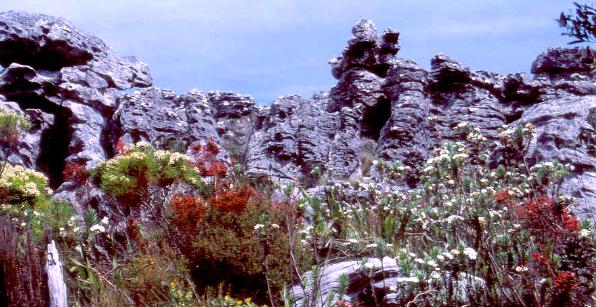 |
Many
of the species presently inhabiting this region are threatened by extinction.
Three-quarters of the plants listed in the latest edition of the
South African Red Data Book are in the Cape Floral Kingdom. The
coastal area has been subject to the multiple pressures of development,
population growth, agriculture, plant collectors and the spread of invasive,
alien plants. It is certainly a great pity that only a very small
percentage of this area has received any form of protection, but soon
after I was there in 1998, the Cape Peninsula National Park was established
and now preserves a very significant expanse that stretches some 60 km
from Cape Town all the way to the tip of the Cape of Good Hope. The
Cape Floral Kingdom and the floristic biomes which it encompasses are
a natural treasure for the people of South Africa and the world, and it is devoutly
to be hoped that more areas will be set aside so that many of these endangered
species will not be forever lost. |
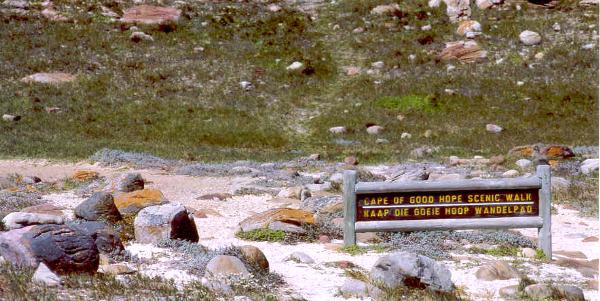 |